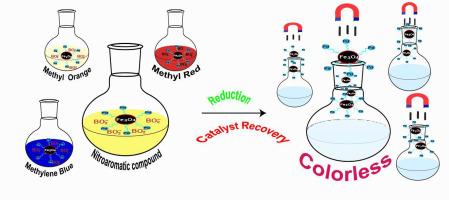磁性可回收钯沉积聚合物刷式催化剂的构建及其对有机污染物的还原作用
IF 5.7
3区 材料科学
Q2 MATERIALS SCIENCE, MULTIDISCIPLINARY
引用次数: 0
摘要
硝基芳香族化合物和合成染料对水体造成严重的环境和健康危害,需要开发高效、可回收、生态友好的催化系统。在这项研究中,通过表面接枝和还原技术合成了一种磁性可回收的Pd - PAAm@Fe₃O₄纳米催化剂,确保了Pd⁰纳米颗粒在聚丙烯酰胺修饰的Fe₃O₄上均匀分散,没有毒性还原剂。该催化剂对2- np、4-NP、2,4-二硝基苯酚、2- na、4-NA和2,4-二硝基苯胺具有良好的还原活性,符合准一级动力学,k -ₚₚ值最高为5.23 min⁻¹。对有机染料的降解速度快,对甲基橙的脱色时间为45 s,对亚甲基蓝的脱色时间为120 s。该催化剂在5个循环中保持了99% %以上的4-NP还原效率,具有低Pd浸出率(0.10-0.16 %)和稳定的结构,经XRD、SEM、TEM和XPS证实,突出了其可持续环境修复的潜力。本文章由计算机程序翻译,如有差异,请以英文原文为准。

Construction of magnetically recoverable palladium deposited polymer brush catalyst for reduction of organic pollutants
Water contamination by nitroaromatic compounds and synthetic dyes poses serious environmental and health hazards, requiring the development of efficient, recyclable, and eco-friendly catalytic systems. In this study, a magnetically recyclable Pd–PAAm@Fe₃O₄ nanocatalyst was synthesized via surface grafting and reduction techniques, ensuring uniform dispersion of Pd⁰ nanoparticles on polyacrylamide-modified Fe₃O₄ without toxic reducing agents. The catalyst exhibited excellent activity for reducing 2-NP, 4-NP, 2,4-dinitrophenol, 2-NA, 4-NA, and 2,4-dinitroaniline, following pseudo-first-order kinetics, with the highest kₐₚₚ value of 5.23 min⁻¹. It also showed rapid degradation of organic dyes, achieving complete decolorization of methyl orange in 45 s and methylene blue in 120 s. The catalyst retained over 99 % efficiency for 4-NP reduction over five cycles, with low Pd leaching (0.10–0.16 %) and stable structure confirmed by XRD, SEM, TEM, and XPS, highlighting its potential for sustainable environmental remediation.
求助全文
通过发布文献求助,成功后即可免费获取论文全文。
去求助
来源期刊

Materials Research Bulletin
工程技术-材料科学:综合
CiteScore
9.80
自引率
5.60%
发文量
372
审稿时长
42 days
期刊介绍:
Materials Research Bulletin is an international journal reporting high-impact research on processing-structure-property relationships in functional materials and nanomaterials with interesting electronic, magnetic, optical, thermal, mechanical or catalytic properties. Papers purely on thermodynamics or theoretical calculations (e.g., density functional theory) do not fall within the scope of the journal unless they also demonstrate a clear link to physical properties. Topics covered include functional materials (e.g., dielectrics, pyroelectrics, piezoelectrics, ferroelectrics, relaxors, thermoelectrics, etc.); electrochemistry and solid-state ionics (e.g., photovoltaics, batteries, sensors, and fuel cells); nanomaterials, graphene, and nanocomposites; luminescence and photocatalysis; crystal-structure and defect-structure analysis; novel electronics; non-crystalline solids; flexible electronics; protein-material interactions; and polymeric ion-exchange membranes.
 求助内容:
求助内容: 应助结果提醒方式:
应助结果提醒方式:


